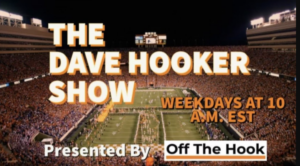In theory, I do not oppose the transfer portal, which now allows college student-athletes to change schools as often as they want without penalty.
In theory, I do not oppose Name Image and Likeness, which allows student-athletes to profit off their image while in college.
But when the two go hand in hand without guardrails, I think it’s a disaster.
Quarterback J.T. Daniels shouldn’t be allowed to play at four different schools in five years.
Freshmen who redshirt shouldn’t be allowed to make $2 million a year while teammates are grinding each week on the gridiron.
This whole system is a mess – and a predictable mess.
If you didn’t see this coming, you were blinded by your desire to empower college athletes.
If you didn’t see this coming, you didn’t look at the big picture.
Many predicted that the transfer portal would lead to mass exoduses from colleges. They were right.
Many predicted that NIL would cause dissension in locker rooms. They were right.
Many predicted that athletes – even at major schools – would sell their talents to the highest bidder, showing zero loyalty to their teammates, coaches or school. They were right.
Former Alabama coach Nick Saban correctly predicted this would be akin to free agency in the NFL. But it’s worse. College athletes have more freedom to change schools than NFL players to do change teams.
Most NFL players have multiyear binding contracts and you can’t randomly switch from one team to another multiple times.
College athletes can come and go as they please, with no repercussion. And they can do it multiple times.
The system has generated, to some extent, quitters.
Don’t like your playing time, quit and enter the portal.
Don’t like the NIL money you make, quit and enter the portal.
Don’t like hard coaching, quit and enter the portal.
That isn’t the case with all that enter the portal. Some are run off – i.e. Deion Sanders at Colorado. Some have a legitimate reason for leaving – like playing behind a star or a coaching change.
But that is not the majority.
I am also bothered by the more than 1,000 football players that entered the portal in 2022 that didn’t find another school and lost their scholarship.
I am bothered by the unsuspecting athlete who signs an NIL deal, only to learn that he is bound to that company or organization for many years AFTER turning pro.
Is there a solution to this madness?
Probably not.
But here are a couple of suggestions that might help.
A Cap
A cap of $25 million is put on each FBS school for NIL money. The NFL and NBA have a salary cap. Why not the NCAA? The NCAA is a voluntary organization and a salary cap per team should hold up in court.
Can you get 130 FBS schools to agree on the salary cap amount? Maybe not. But it’s better than the Wild, Wild West bidding wars we have out there now.
FCS schools could have a $5-10 million salary cap. That would at least give some FCS teams a chance to keep key players from bolting to the FBS.
Division I basketball teams could also have a $10 million salary cap.
Transparency
Disclose the NIL deals for each athlete. The private schools would balk at this, but there are only a handful of private schools that are relevant at this level.
Public school coaches’ salaries are public. Why not athletes at public schools?
This would force schools to be more equitable in their distribution of NIL money to athletes rather than have clandestine deals.
And perhaps it would curb some of the dissension in the locker room when starters discover backups are making more money.
Limit Transfers
Limit the number of undergraduate transfers to one and graduate transfers to one. That way, an athlete could play at a maximum of three schools. This would prevent a J.T. Daniels from playing at USC, Georgia, West Virginia and Rice.
2-year Commitment
Players could not transfer until playing two seasons at a school unless there is a head-coaching change.
Too often, when the going gets tough, players quit – especially after one year or one semester.
The current rules encourage quitting because it’s too easy to transfer without penalty.
By not allowing transfers after one semester, this could entice players to stick it out and not throw in the towel at the first sign of adversity.
Let’s face it: The current system is not sustainable.
And if guardrails aren’t put in place soon, college athletics will implode within the next five years.
And that will be detrimental to fans, athletes and coaches.












20 Responses
also, a transfer should not be allowed to play against the team that he is leaving..
Well spoken, Jimmy!
I’ve said since this started instead of NIL, they should have went with a player stipend(same amount to every player, in every sport, across DI, different $ amount at D2, D3.). And high school players should NOT have any NIL deals! If it was level amounts across the board, players would have spending money, team equity, and less reason to try and leverage school vs school in a bargaining deal. No reason Johnny QB should have a 7 figure NIL deal and Sally Softball Star gets $100/month to be pictured in a restaurant ad. NIL and free multi transfer will ruin college athletics. I don’t feel sorry for any athlete who went to portal and had no takers. Guess they learn the hard way!
I couldn’t agree more. The NIL is less than 5 years old but Tennessee is already paying a quarterback who had never played a game (at the time of the signing) 2 million a year. What will they be getting in 10 years of this keeps going unchecked? Coaches are already signing 100 million dollar deals. How long before 5 star recruits start demanding close to that as freshman?
There has to be a max per position. Not 2 million /yr for QBs. It should have been limited to 1 million and any marketing deals. Any school who breaks the rule be penalized half the max amount. Enter the NIL only one time period. Not happy with the deal you got.. sorry. You had your chance. Teams have to have some sense of stability at some point. You think you have your team the the second round of NIL takes some key players off your team. For what reason…got yelled at? Got to run. Got disciplined for actions? Got to run. Man they had all the time in the world to mill over the good and the bad. And this is what you came up with? It’s like the wild wild west, anything goes. And its rediculous.
You are absolutely correct I agree with everything you have said
Up to 80% of the NIL is paid after the bowl game. If a win all of it is paid. A loss 40% is paid
Good analysis and sime good potential solutions.
Always have enjoyed watching/reading your football commentary and learning from your knowledge of the game.
Amen, big mess. Will eventually hurt fan support if not already. Lose fans lose money…ie…meltdown.
Anyone who didn’t see this as a train wreck is blind – there have to guidelines/policy around this – college players getting this kind of endorsement money is insane –
I agree 100% with Jimmy.
I agree with you 100%.
Totally agree on limiting transfers. This is 18 19 year olds that are making money an that is all they see an not getting a life lesson on the real world that it’s tough.
100% Agree! Athletic College scholarships used to be the vehicle many kids had to get a college degree, & a minority of players making the big leagues. Yes, they made money for the colleges, & yes, they deserve some compensation, but current system is CRAZY! THIS PRO-COLLEGE FOOTBALL. Limit compensation on an equal basis / performance. A kid sitting on the bench shouldn’t get $8 mil, while Joe Nobody is getting his guts pounded out on the line, a position he EARNED WORKING FOR IT, and was a walk-on or lower recruit.
I agree with this article. This needs to stop before College Athletics is destroyed. I would say ONE transfer and that’s it. The money issue is tough….somehow all should share at some level in the NIL funds.
Please stay on this topic….we need to save college football.
That is absolutely the best article I’ve ever read on NIL. Couldn’t agree more.
Jimmy Hyamm’s suggested restrictions on athletes transferring multiple times sounds reasonable to me, but I’m not playing or coaching. However, the potential harm that unrestricted transfers pose to small schools’ athletic programs seems evident. Some guardrails are definitely warranted. The issue of NIL deals appears significantly more complicated, but greater transparency, as suggested, does seem like a reasonable part of the solution. More equitable allotment of payments among athletes is another. But, who would be responsible for that? It seems chaos will remain for the foreseeable future.
They need to fix the transfer portal. You shouldn’t be able to transfer but one time and then you should have to sit out a year. I don’t mind the kids getting some money but it should be around 500 to 1000 a month at the most. They already getting a free education.
This year’s bowl games I didn’t like because of the way they got things all messed up. They were not the same without the regular players there with there team playing. They’ve made a big mess.
None of it should have ever happened. As the author says,
College athletes can come and go as they please, with no repercussion. And they can do it multiple times.
The system has generated, to some extent, QUITTERS!
Don’t like your playing time, quit and enter the portal.
Don’t like the NIL money you make, quit and enter the portal.
Don’t like hard coaching, quit and enter the portal.
Most star athletes are already convinced they are special. Some pass courses they cannot pass. They are treated like royalty but most of all they get a very expensive education with free everything that most could not afford otherwise.
Other than the excitement of competitive sports what value do they bring to society? Only a small percentage will make it to the NFL and of those that do a percentage get their millions and are bankrupt as soon as their playing days are over.
All this to say they have ruined college football and these changes should be resented immediately.